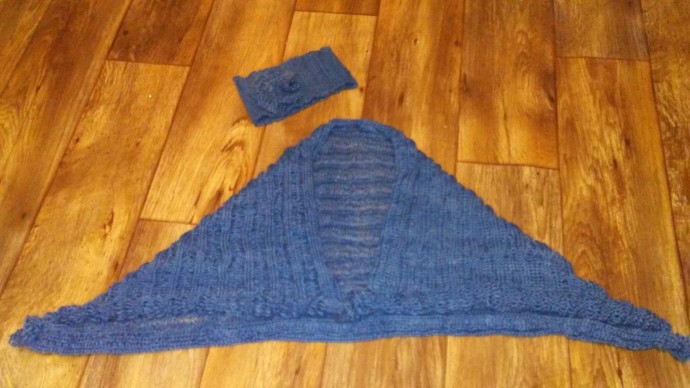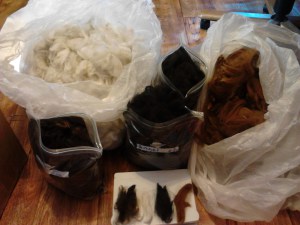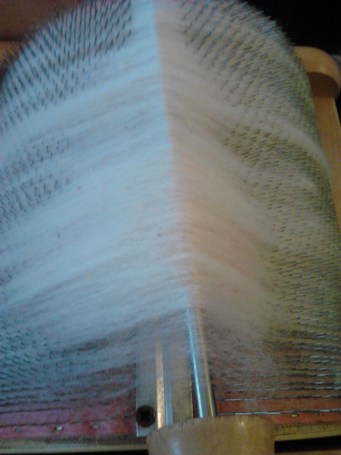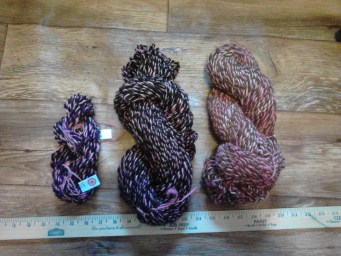My friend and mentor, Mrs. W., and I have been trying to set up a fiber day since early spring brought fresh breezes and hints of free time. The summer sped by, and though every golden day was filled with good things, the visit remained a thing of the future until this week. Saturday, my sister and I finished our chores and drove over, feeling a bit tired from the week’s adventures.
When we saw our friend, however, and felt the sun-warmed breeze that breathed across the valley, we felt refreshed and excited for the chance to visit. The first stop on the farm was the fiber room, a small finished building beautifully painted in pastels and home to an antique carpet loom, totes of clean fiber, and essential tools. The room is well-lit and has a fresh, cheerful atmosphere. The sheepdog lays at the foot of the loom or in the doorway with a stick in her mouth and a happy question in her eyes. We looked at the project on the loom and were invited to try weaving a heavy carpet with a white cotton warp, and a weft of plastic baling twine, the stuff that held the sheeps’ dinner together. It is not only a creative recycling project, but also a durable carpet project that goes along quickly. You can really experience weaving progress with baling twine! The various shades of light blue made a cloudy effect and the royal blue added contrast. After I wove a few lines, my sister took over and became addicted to the process. Like spinning, there is a comfortable rhythm to the whole series of actions that soothes the mind while it exercises the body.
My friend has asked us over to see if we want some of her stored wool. If not, it will be turned out for compost, nourishing the soil and growing beautiful vegetables and flowers on her farm. Having an idea of the labor of love that has gone into the fiber to bring it to this stage, it makes me feel queasy to think of it even touching a compost pile, and I’m eager to see what is in the box. When several boxes are opened, and I run my fingers through the wool of Leicester, churro, Wensleydale, and several others, I feel overwhelmed with amazement. What treasures are mine today! While my sister weaves, we begin to pack the fiber into bags for transport. Mrs. W. is glad to have storage space, and I feel like a fiber pirate carrying off a cargo of loot. She mentions she hopes it will be ok with our parents at home, and I assure her they know it is coming.
We have spent some time de-cluttering the attic this week, partly to relieve the floors. Book lovers need strong floors, which we have, but it is still disconcerting to sleep beneath a small-scale library of congress. I mentally calculate space, and realize I’ll need to work out some extra space, but it is so worthwhile!
The fibers glisten in the late summer afternoon sunlight, and as the dark fibers warm, they become especially soft and cozy. The white wool speaks to me of colorful dyeing sprees on winter afternoons when the bleakness of winter seems indomitable. It gives me a kind of satisfaction to fight the bone-crunching cold, sloppy slush, and general grayness of winter with sunny yellow, spring green, magenta, indigo, red, purple, peach, coral, and any surprising combination that happens to pop up in the fiber. In winter, the warm kitchen comes alive with light, music, good cooking, and a colorful project going on. It is a good place to be.
To me, a recipe for a good project begins with a person who loves to serve, fresh materials, and most of all, SURROUND SOUND! Actually, that’s not a bad recipe for most projects.
After we loaded the wool into the car, Mrs. W. asked if we could use any tomatoes. Her garden is quietly producing a bumper crop of delicious red heirloom tomatoes. While we picked some, I was reminded of the time another sister asked me to come over and lend a hand while she was delivering her twins. She too had a garden of tomatoes to deal with, but a limited amount of time and energy. We washed the tomatoes, cut out the top area, quartered them, and chopped them quickly, skins and all, in a blender. Then, we put the sauce into a crock pot and slowly cooked it overnight with a toothpick under the lid to allow moisture to escape. In the morning, I added green pepper, onion, herbs, salt, and oil. It tasted acidic, and I remembered my sister did not deal with acids well. What could I do to decrease the acid without losing that great thick and chunky texture? I remembered that when we maintained a pool, the chlorine would raise the acidity and we would use baking soda to counter the effect. “Well, it is a food ingredient,” I thought, “and I’m planning to freeze it instead of canning it, so decreasing the acid really will not be a food safety problem.” I decided to add a pinch and saw the sizzling and sputtering with satisfaction. After stirring and waiting for the foam to go down, I tasted a bit and found the acid much reduced. A little brown sugar finished the sauce to perfection. My sister enjoyed the sauce with no unpleasant effects, and it was declared a success, even by my picky eating brother-in-law.
My friend was glad to hear of a quicker method for processing the crop, and we agreed that it ruined the traditional canning method forever. A professional teacher considering retirement in the next five years or so, she loves working with her farm and her students and is looking for a way to combine her skills without giving up what she loves or her income. I suggested developing a retreat for groups of fiber enthusiasts to attend, spend time in the country, and learn the process of wool preparation from sheep to finished product. I am sure our fiber friends from all over would enjoy the learning and fellowship, but especially those who live in big cities like Manhattan. Folks who wish for a garden and livestock, but make do with a windowbox and an angora. I have read your posts, and know you long for a day like the one I just had. A weekend, or half-week would be even better, right?
She is attracted to the idea, and has been told by her Amish farm helper that if she started a fiber processing venture, several local people would be interested in working to make it come together. It is exciting to contemplate, don’t you think? I am interested in hearing your thoughts, questions, and concerns, but especially your experiences.
When I was a member of a New York quilt guild, several members would take a week or weekend to go to a campground and return, having made an entire quilt while away. They came back aglow with ideas, techniques, contacts, and information to share with the rest of the group. I began to notice that often, those with specialized, highly developed skills do much of their work alone. They learn to deal with the quiet, and maybe the skills are a way of helping with unavoidable loneness.
Finding fellow fiber enthusiasts next door is uncommon, and the internet, while very helpful for obtaining supplies, ideas, patterns, pictures, and just about everything else, comes up short in the area of actual friendships and the essential, elusive joy of being in the presence of someone who understands. Someone who wants to join minds and handiwork in the amazing process of becoming a team. The best kind of team feels the anxiety of new beginnings and acceptance, the patient plodding for improvement, and the joy of success mixed with plans for further development. Could that happen for us in central Pennsylvania? What do you think?

The golden honey batt.

Smoothing it back with my hand helps.
















































